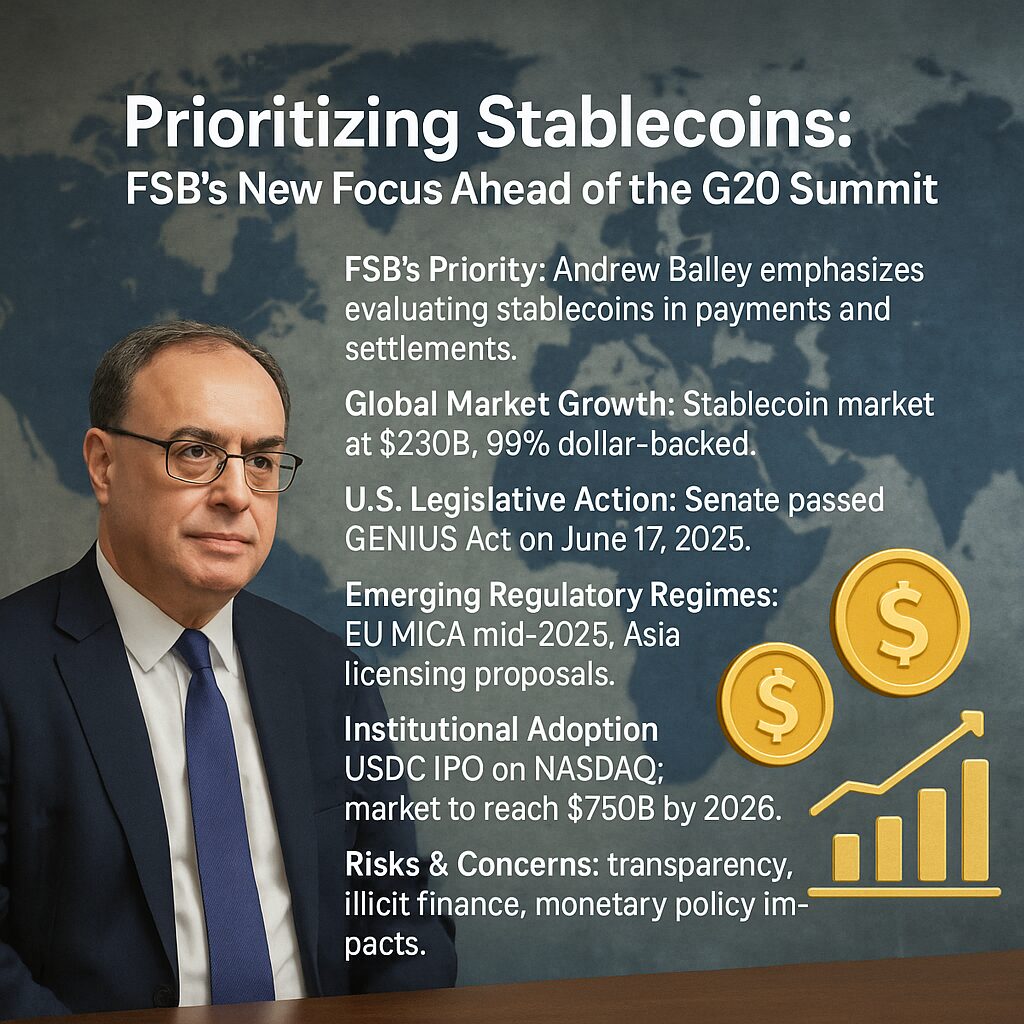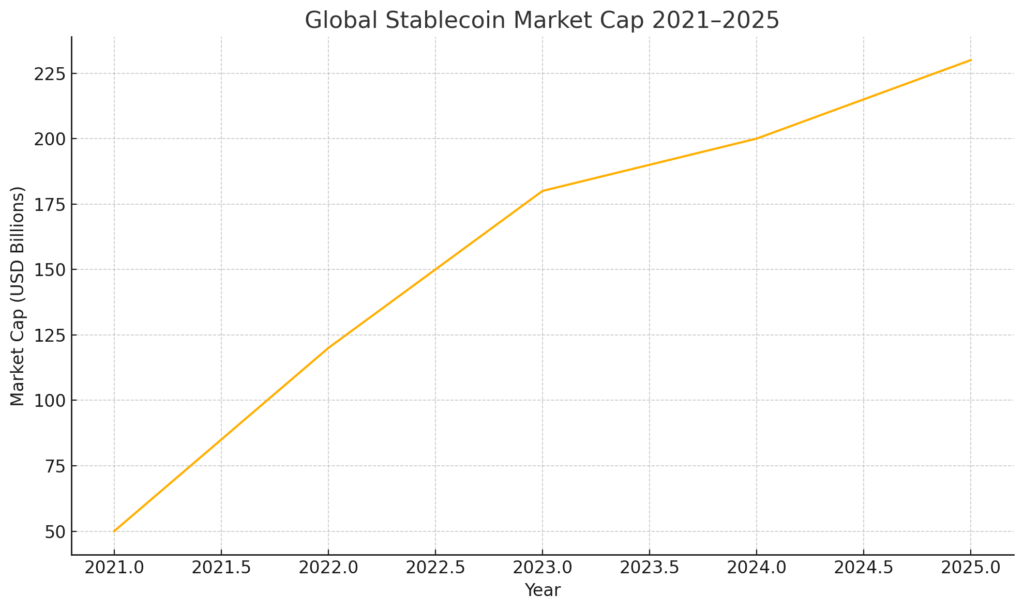
Main Points:
- FSB’s Priority: Andrew Bailey, newly appointed FSB Chair, emphasizes evaluating stablecoins’ roles in payments and settlements ahead of the July 17–18 G20 meeting.
- Global Market Growth: The stablecoin market has surged to over $230 billion, with dollar-backed coins comprising 99% of the total.
- U.S. Legislative Action: The U.S. Senate passed the GENIUS Act on June 17, 2025, establishing the first comprehensive federal framework for payment stablecoins.
- Emerging Regulatory Regimes: The EU’s MiCA regulations will take effect in mid-2025, while Asia is proposing new licensing regimes for issuers.
- Institutional Adoption: Circle’s USDC IPO on NASDAQ and Standard Chartered’s forecast of a $750 billion market by 2026 highlight increasing institutional confidence.
- Risks & Concerns: Authorities worry about reserve transparency, illicit finance, impact on monetary policy, and the potential for fragmentation of credit creation.
FSB’s Stance on Stablecoins
In a letter dated July 14, 2025, to G20 finance ministers and central bank governors, Andrew Bailey—recently appointed as Chair of the Financial Stability Board (FSB) and Governor of the Bank of England—stated that assessing the role of stablecoins in payments and settlements would be a top priority for the FSB. He emphasized that the FSB will continue implementing its agreed-upon recommendations from 2021 and monitor developments cross-border, ensuring that jurisdictional differences do not undermine global financial stability.
Bailey also underscored the need to evaluate how stablecoin issuance by large global banks could reshape credit creation and weaken the efficacy of traditional monetary policy tools, echoing concerns he raised in a recent interview with The Times.

Explosive Global Market Expansion
Since the FSB’s initial 2021 proposal to regulate global “systemic stablecoins,” the market has experienced exponential growth. As of mid-2025, total market capitalization has soared to approximately $230 billion, up from around $50 billion in 2021. Dollar-backed stablecoins account for over 99% of this market, reflecting their dominance in facilitating cross-border transfers and crypto trading.
Institutional interest has surged: Circle Internet Group’s decision to launch an IPO on the NASDAQ marks a milestone in mainstream finance embracing stablecoins, signaling public company status and heightened regulatory scrutiny.
U.S. Legislative Developments: The GENIUS Act
On June 17, 2025, the U.S. Senate passed the GENIUS Act (S. 1582), formally titled the Guiding and Establishing National Innovation for U.S. Stablecoins Act. This bipartisan legislation mandates:
- Stringent Reserve Standards: 1:1 backing with high-quality liquid assets.
- Regular Audits & Transparency: Mandatory disclosure of reserves and proof-of-reserve audits.
- Dual Federal–State Supervision: Shared oversight to mitigate regulatory arbitrage.
With a 68–30 vote, the Senate’s passage marked the first time Congress approved a comprehensive stablecoin framework. However, procedural setbacks occurred when the House rejected the rule to consider the bill in mid-July, sending it back to the Senate on July 15.
Regional Regulatory Landscapes
European Union: MiCA Implementation
The EU’s Markets in Crypto-Assets (MiCA) regulation, adopted in 2023, will fully apply by July 2025, introducing licensing requirements for issuers and supervisors. Under MiCA, stablecoins must:
- Maintain safeguarded reserves.
- Submit regular reports to the European Securities and Markets Authority (ESMA).
- Comply with consumer protection and anti-money laundering (AML) standards.
Asia-Pacific Initiatives
Countries such as Singapore, Japan, and South Korea are advancing licensing frameworks. For example:
- Singapore’s Payment Services Act (PSA) now includes a specific “stablecoin license.”
- Japan’s Financial Services Agency (FSA) proposes an amendment to treat stablecoin issuers as trust companies.
These regimes aim to bolster investor confidence while addressing local AML and consumer-protection concerns.
Institutional Momentum & Future Projections
In July 2025, Standard Chartered’s research head projected the stablecoin market could triple from $240 billion to $750 billion by 2026. Such growth would compel significant U.S. Treasury issuance to back reserves, potentially reshaping the yield curve and liquidity dynamics in sovereign debt markets.
Analysts at J.P. Morgan caution that while total market size is roughly $250 billion, only $15 billion—about 6%—is currently used for routine payments, with the majority concentrated in trading and DeFi collateral.
Key Risks and Policy Considerations
- Reserve Quality & Transparency: Inadequate auditing or opaque asset backing could trigger liquidity crises, undermining trust and risking contagion into traditional markets.
- Monetary Policy Efficacy: Large-scale issuance of stablecoins could divert deposits from commercial banks, affecting credit supply and deposit-based monetary controls.
- Illicit Finance & AML: Rapid, low-cost cross-border transfers heighten concerns over money laundering, terrorism financing, and sanctions evasion.
- Competition with CBDCs: Central Bank Digital Currencies (CBDCs) may offer safer, government-backed alternatives, challenging private stablecoin adoption.
Practical Implications for Blockchain Projects
For developers and businesses exploring new blockchain applications:
- Integration Opportunities: Leverage stablecoins for low-volatility payments rails in DeFi, cross-border remittances, and tokenized asset platforms.
- Compliance Readiness: Anticipate reserve and transparency requirements when choosing a stablecoin partnership.
- Risk Mitigation: Employ multi-signature custody and reputable reserve custodians to ensure audit compliance and user trust.
- Market Differentiation: Consider layer-2 network integration for low fees and enhanced transaction throughput.
Conclusion
Stablecoins have matured from nascent crypto instruments to systemic considerations for global regulators and financial institutions. The FSB’s prioritization ahead of the G20 underscores the urgency of balancing innovation with stability. U.S. legislative milestones like the GENIUS Act, the EU’s MiCA rollout, and Asia-Pacific licensing reforms form a patchwork of frameworks that will shape stablecoin issuance and use. As the market heads toward a potential $750 billion valuation by 2026, stakeholders—from blockchain startups to central banks—must navigate evolving regulatory landscapes, operational risks, and the strategic opportunities that stablecoins present in payments, settlements, and beyond.

